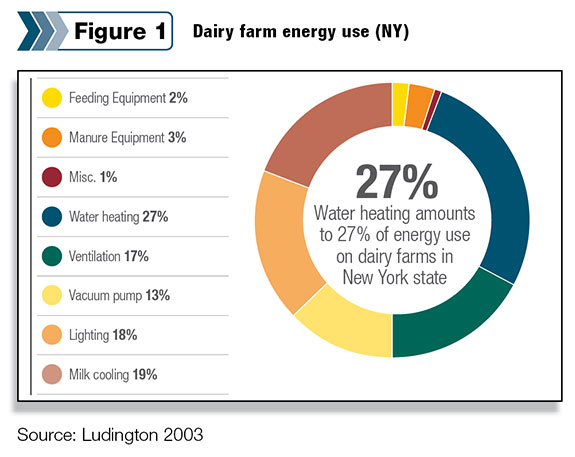Energy use for milk harvesting and animal housing on dairy farms is typically less than 2 percent of overall production costs. Energy savings can be economically important with little management time. It is important to know where and how energy is being used as we look for energy savings.
Many utility and state energy efficiency programs offer energy audits on farms to help determine what can provide the best return on investment.

Figure 1 is the distribution of energy use on dairy farms in New York based on a 2003 study. One thing that might surprise some people is the low amount of energy used for feeding and manure handling due to large motors that often don’t run for long periods of time.
Energy efficiency doesn’t have to cost thousands of dollars but one also needs to look beyond the initial equipment costs and include the energy use and sometime maintenance costs when making investment decisions.
Water heater A may cost $1,000 more than water heater B, for instance, but if A uses 25 percent less energy it may pay for the additional investment in a few years. If one looks at the initial cost and doesn’t take into account the lower energy cost, you’ll be pennywise but dollar foolish.
Let’s try to identify options for reducing energy.
Water heating is the largest and often easiest to cut. When cooling milk, the refrigeration system will typically reject heat to the air, but if a refrigeration heat recovery (RHR) unit is used, up to 50 percent of the heat removed from milk can be captured to pre-heat the water before it enters the water heater. Typically a dairy farm can reduce water-heating costs by 50 percent using a RHR unit. Large farms can often benefit from multiple units.
Another cost saver is to use water directly from the RHR for non-critical uses such as parlor cleanup after milking. Having your dairy equipment dealer tune up the washing system can also reduce hot water use. Milk cooling can be reduced using an efficient refrigeration compressor such as a Scroll compressor (15 percent savings) or by using a well water-cooled pre-cooler (heat exchanger) to reduce milk temperature before it enters the bulk tank.
With proper sizing and adequate water flow, the milk temperature can be reduced to within 3-4°F of the well water temperature. If you have an existing pre-cooler and the milk temperature isn’t getting cold, the water to milk flow ratio needs to be increased or more surface area is needed (more time for heat transfer).
Most often the piping to the pre-cooler is undersized and increasing the pipe size to 1 inch will reduce the milk temperature from exiting. A two-to-one water to milk flow ratio or more is needed to get maximum cooling. If the water system can’t supply enough water, a variable speed milk pump will reduce the milk-flow rate through the precooling process, increasing heat transfer and resulting in cooler milk.
On farms with fewer than 100 cows, typically a pre-cooler or RHR will be economical. Cleaning the condenser unit heat exchanger twice annually can reduce milk-cooling costs by 3-5 percent. Reducing ventilation energy costs is largely about maintenance — semi-annually cleaning blades, guards, motors and housings, and keeping belts tight.
Purchase fans with efficiency ratings of 20 cfm per watt or higher at a static pressure of 0.05” H2O. Variable speed vacuum pumps can typically save 50-65 percent in energy costs over constant speed vacuum pumps. They are typically economical when milking six to eight or more hours per day.
Lighting is what we call low-hanging fruit because the return on investment is usually excellent. If you’re still using incandescent bulbs, you are basically doing the equivalent of hand milking. Lighting technology has made great strides in the past 10 years with new lamps being more efficient, having longer lamp life and excellent light quality.
New LED lamps last 25,000 hours to more than 100,000 hours, have high color quality, don’t contain mercury and are up to seven times more energy efficient than incandescent bulbs. They cost more but if you account for the reduction in energy use and lamp life, ownership costs are about one-third of incandescent bulbs.
We’ll discuss LED lamps further in a future column. PD





